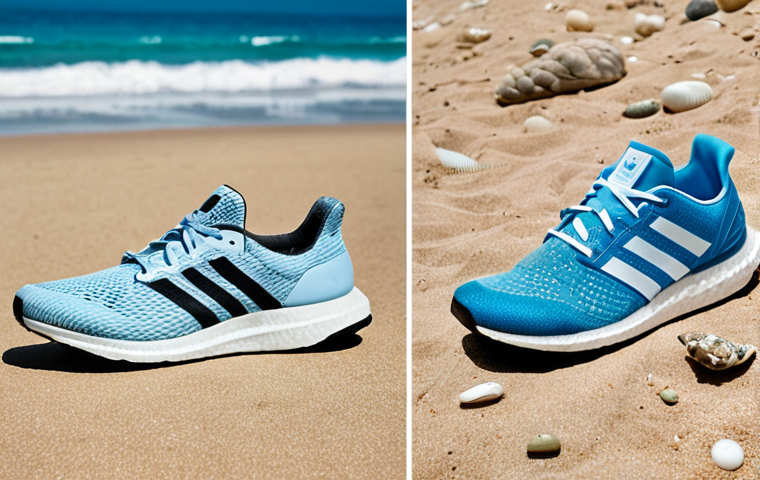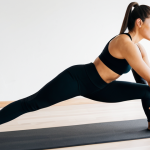Choosing the right running shoes can feel like a marathon in itself, right? You’re caught between the swoosh of Nike and the stripes of Adidas, each promising the ultimate running experience.
I’ve personally pounded the pavement in both, and it’s a tough call to make. The latest trends suggest a surge in sustainable materials and personalized fit technology, but how does that translate to actual performance?
And with predictions pointing towards more data-driven shoe design, are we on the cusp of a running revolution? Let’s dive in and explore the nuances of Nike versus Adidas, to help you pick the perfect pair for your stride!
We’ll discover which brand truly shines. Let’s figure out which brand is the best together!
Decoding the Lingo: Key Features Unveiled

The Tech Talk: Nike’s Innovations
Nike is often seen as the frontrunner in innovation, constantly pushing the boundaries of what’s possible in running shoe tech. Their Flyknit technology, for instance, provides a sock-like fit that’s both breathable and supportive. I remember the first time I slipped on a pair of Flyknits – it felt like running on clouds, or at least a very cushioned track. And let’s not forget about React foam, which offers a responsive and springy ride. It’s the kind of cushioning that makes you want to run just a little bit further. But all this tech comes at a cost, both in terms of price and sometimes durability. I’ve had Flyknits that have lasted for years, and others that have worn out in months, so it can be a bit of a gamble.
Adidas’ Counterpunch: Boost and Beyond
Adidas, not one to be outdone, brought us Boost technology, which revolutionized cushioning. Boost is made of thousands of tiny foam capsules that store and release energy with each stride. I’ve always found Boost to be a bit firmer than React, but it’s incredibly durable and maintains its responsiveness over time. I have a pair of Ultraboosts that I’ve put hundreds of miles on, and they still feel great. Adidas has also been making strides in sustainable materials, with their Primeblue fabric made from recycled ocean plastic. It’s a great way to feel good about your purchase, knowing that you’re helping to reduce waste.
Fit and Feel: Finding Your Perfect Match
Nike’s Snug Embrace: Narrow Feet Rejoice?
Nike shoes generally tend to have a snugger fit, which can be great for runners with narrower feet. I have fairly narrow feet myself, and I often find that Nikes fit me like a glove right out of the box. The downside is that they can feel a bit constricting for those with wider feet. I’ve seen friends struggle to find a comfortable fit in Nikes, often having to go up a size or even try a different brand altogether. It’s always best to try on shoes in person to make sure they fit properly, especially if you have wider feet.
Adidas’ Roomy Comfort: Wide Feet Welcome
Adidas, on the other hand, often offers a more accommodating fit, with a wider toe box and more room overall. This can be a lifesaver for runners with wider feet or those who prefer a bit more wiggle room. My buddy, who has notoriously wide feet, swears by Adidas. He says they’re the only brand that doesn’t make his feet feel cramped and uncomfortable. Adidas’ Primeknit uppers also tend to be more stretchy and forgiving than Nike’s Flyknit, which can further enhance comfort for those with wider feet.
Lace ‘Em Up: Lockdown and Support
The lacing system and overall support structure of a running shoe play a crucial role in how it feels on your foot. Nike often uses innovative lacing systems that provide a secure and customized fit. I’ve always been impressed with how well Nike shoes lock my foot in place, preventing slippage and reducing the risk of blisters. Adidas, too, offers excellent lockdown, with some models featuring a midfoot cage that provides additional support. It really comes down to personal preference and finding a shoe that fits your foot shape and running style.
Performance on the Road: Which Shoe Excels?
Speed Demons: Racing Flats and Tempo Trainers
When it comes to speed, both Nike and Adidas have a lot to offer. Nike’s Vaporfly and Alphafly series have revolutionized marathon running, with their carbon fiber plates and responsive cushioning. I’ve never run a marathon in Vaporflys, but I’ve worn them for shorter races and tempo runs, and they definitely give you an extra spring in your step. Adidas’ Adizero series is another popular choice for racing, offering a lightweight and fast feel. I used Adizero Adios for a 10k, and it helped me improve my time by quite a bit. The choice between Nike and Adidas for speed really depends on your individual preferences and running style.
Endurance Kings: Long Runs and Daily Training
For long runs and daily training, comfort and durability are key. Nike’s Pegasus and Vomero series are popular choices for their cushioning and support. I’ve put hundreds of miles on Pegasus shoes, and they’ve always been reliable and comfortable. Adidas’ Ultraboost and Solarboost series are also great options for everyday running, offering a plush and responsive ride. I alternate between Ultraboosts and Pegasuses for my daily runs, depending on how my feet are feeling. Ultimately, the best shoe for endurance is the one that feels the most comfortable and supportive for you.
Style and Aesthetics: Looking Good While You Run
Nike’s Bold Statements: Iconic Designs
Nike has a knack for creating eye-catching designs that stand out from the crowd. Their shoes often feature bold colors, futuristic shapes, and iconic logos. I’ve always been drawn to Nike’s aesthetic, and I love the way their shoes look both on and off the road. The Air Max series, in particular, is a classic example of Nike’s design prowess, blending style and performance seamlessly. Of course, style is subjective, and what looks good to one person may not appeal to another.
Adidas’ Understated Elegance: Classic and Clean
Adidas tends to favor a more understated and classic aesthetic, with clean lines, simple color palettes, and timeless designs. Their shoes often have a minimalist feel that appeals to those who prefer a more subtle look. I appreciate Adidas’ attention to detail and their ability to create shoes that are both stylish and functional. The Stan Smith and Superstar are iconic examples of Adidas’ design philosophy, transcending trends and remaining popular for decades.
Sustainability Matters: Eco-Friendly Options
Nike’s Move to Zero: Reducing Their Footprint
Nike has been making a concerted effort to reduce its environmental impact through its Move to Zero initiative. This includes using more recycled materials, reducing waste in their manufacturing process, and designing shoes that are more durable and long-lasting. I’ve been impressed with Nike’s commitment to sustainability, and I appreciate that they’re taking steps to reduce their footprint. However, there’s still a long way to go, and Nike needs to continue to innovate and improve its sustainability practices.
Adidas’ Primeblue and Parley: Turning Trash into Treasure
Adidas has partnered with Parley for the Oceans to create Primeblue, a fabric made from recycled ocean plastic. This innovative material is used in many of Adidas’ running shoes, helping to reduce plastic waste and protect our oceans. I think it’s great that Adidas is finding creative ways to use recycled materials, and I hope to see more brands following suit. Adidas’ commitment to sustainability is not just a marketing ploy, it’s a genuine effort to make a positive impact on the planet.
The Price Tag: Balancing Cost and Value
Nike’s Premium Pricing: Is It Worth It?
Nike shoes often come with a premium price tag, reflecting their innovative technology, stylish designs, and brand recognition. But is it worth the extra cost? That depends on your individual needs and priorities. If you’re a serious runner who values performance and innovation, then Nike’s premium pricing may be justified. However, if you’re a casual runner or on a tight budget, there are plenty of other great options available at lower price points.
Adidas’ Competitive Edge: Value for Money
Adidas often offers a more competitive price point than Nike, making their shoes accessible to a wider range of runners. While Adidas shoes may not always have the same level of cutting-edge technology as Nikes, they still offer excellent performance and durability. I’ve always found Adidas to be a great value for money, offering a good balance of quality and affordability. Plus, Adidas often has sales and discounts, making it even easier to find a great deal.
Making the Choice: Your Personal Running Journey
Know Thyself: Understanding Your Needs
The most important factor in choosing between Nike and Adidas is understanding your own needs and preferences. Consider your foot shape, running style, training goals, and budget. Try on shoes from both brands and see which ones feel the most comfortable and supportive. Don’t be afraid to ask for advice from running store employees or other runners. And remember, the best shoe is the one that works best for you, regardless of the brand.
The Test Run: Trying Before You Buy
Whenever possible, try to test run shoes before you buy them. Many running stores will allow you to run on a treadmill or even take the shoes outside for a short test run. This is the best way to get a feel for how the shoes perform and whether they’re a good fit for you. Pay attention to how the shoes feel on your feet, whether they provide enough cushioning and support, and whether they cause any discomfort or rubbing.
Here’s a comparison table to help you visualize the key differences:
| Feature | Nike | Adidas |
|---|---|---|
| Fit | Snug, often better for narrow feet | Roomy, often better for wide feet |
| Cushioning | React foam, generally softer | Boost, generally firmer and more durable |
| Style | Bold, iconic designs | Understated, classic designs |
| Sustainability | Move to Zero initiative | Primeblue fabric from recycled ocean plastic |
| Price | Often premium pricing | Generally more competitive pricing |
In Conclusion
Choosing between Nike and Adidas running shoes ultimately boils down to personal preference and your individual needs as a runner. Consider factors like fit, cushioning, running style, and budget. Don’t hesitate to try on multiple pairs and even take them for a test run. The perfect shoe is out there – happy running!
Good to Know Information
-
Sock Thickness Matters: The thickness of your socks can affect how your running shoes fit. Experiment with different sock thicknesses to find the most comfortable fit.
-
Replace Your Shoes Regularly: Running shoes typically last for 300-500 miles. Track your mileage and replace your shoes when they start to lose cushioning or support.
-
Consider Orthotics: If you have foot problems like flat feet or high arches, consider using orthotics to provide extra support and cushioning.
-
Proper Lacing Techniques: Different lacing techniques can help improve fit and prevent issues like heel slippage or toe numbness. Research different lacing methods and find one that works for you.
-
Visit a Specialty Running Store: Employees at specialty running stores can provide expert advice and help you find the perfect shoe for your needs. They can also analyze your gait and recommend shoes that are appropriate for your running style.
Key Takeaways
-
Fit is Paramount: Prioritize fit above all else. A shoe that fits well will prevent blisters and discomfort, allowing you to focus on your run.
-
Cushioning Preferences Vary: Some runners prefer soft cushioning, while others prefer a firmer feel. Experiment with different cushioning technologies to find what works best for you.
-
Consider Your Running Style: Your running style (e.g., neutral, overpronation, supination) will influence the type of shoe that’s right for you. Consult with a running store employee to determine your running style and get recommendations.
-
Don’t Be Afraid to Experiment: The best way to find the perfect running shoe is to try on multiple pairs and experiment with different brands and models.
Frequently Asked Questions (FAQ) 📖
Q: I’m a beginner runner, only doing a few miles a week. Should I prioritize Nike or
A: didas, or does it even matter at this stage? A1: Honestly, as a beginner, the brand is less important than the fit and feel! I remember starting out, totally overwhelmed.
Don’t get bogged down in the Nike vs. Adidas debate just yet. Head to a running store (the kind where they watch you run on a treadmill!) and get properly fitted.
Comfort is key when you’re building up mileage. Both Nike and Adidas have great entry-level options, but the shoe that feels best on your foot will make the biggest difference in avoiding blisters and staying motivated.
Think of it like this: a comfy shoe is a happy shoe, and a happy shoe makes for a happy runner!
Q: I’ve heard
A: didas Boost technology is amazing, but Nike’s Air system is iconic. Which one provides better cushioning and energy return for long runs (like half marathons)?
A2: Ah, the age-old Boost vs. Air debate! I’ve logged serious miles in both.
My experience? Adidas Boost is like running on little clouds – incredibly plush and responsive, especially over longer distances. You really feel that bounce-back energy.
Nike Air, on the other hand, can feel a bit firmer, depending on the model. I find Air systems are great for speed work and shorter races. For half marathons, I personally lean towards the consistent comfort and energy return of Boost.
But it really boils down to personal preference and how your feet respond. Some people swear by Air for its stability!
Q: I’m trying to be more eco-conscious. Do Nike or
A: didas offer more sustainable options these days? Are they actually durable, or will I be replacing them every few months? A3: Good on you for thinking green!
Both Nike and Adidas are definitely stepping up their sustainability game, which is awesome. Adidas, in my opinion, has been leading the charge a bit more aggressively, particularly with their use of recycled ocean plastic in many of their uppers.
Nike is catching up with initiatives like using recycled materials in their Flyknit technology and focusing on reducing their carbon footprint. As for durability, it really depends on the specific model and how much you’re running.
Generally, sustainable shoes are just as durable as their non-sustainable counterparts these days. Just check reviews and maybe rotate between two pairs to extend their lifespan.
A little extra care goes a long way, both for your feet and the planet!
📚 References
Wikipedia Encyclopedia
구글 검색 결과
구글 검색 결과
구글 검색 결과
구글 검색 결과
구글 검색 결과






